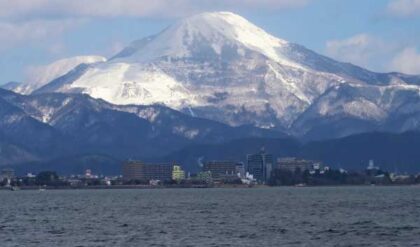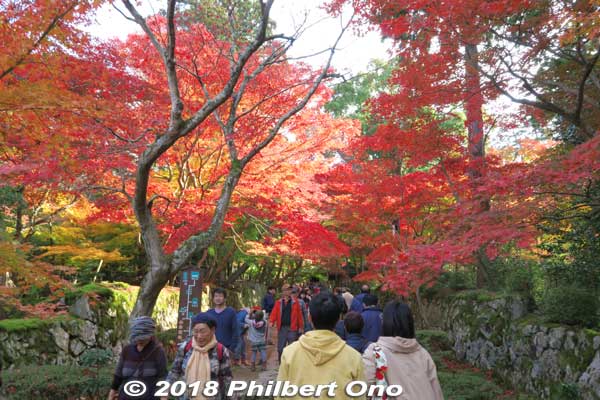This page is outdated. See the latest version here: https://shiga-ken.com/blog/2017/04/videos-of-golden-week-festivals-in-shiga/
Golden Week is Japan’s spring vacation from late April to early May with a string of national holidays. April 29 is Showa Day (set to April 30 this year since the 29th is Sun.), May 3 is Constitution Day, May 4 Greenery Day, and May 5 Children’s Day. This year’s calendar in 2012 can make it a nine-day holiday for the working folk if they only take off on two working days (May 1 and 2).
In Shiga, it is prime time for matsuri festivals. There are so many matsuri during this time that it took me at least 4 or 5 years to see most of them because many are held at the same time. You really have to decide which one to see. The festivals will be extra special this year because many GW festivals were canceled or postponed last year due to the 3/11 triple disasters.
Here are some of the GW matsuri I recommend seeing. A wide variety for sure. Click on the image to see more photos and information of the respective festival. Maps of the shrine locations, etc., are provided by the Map links.
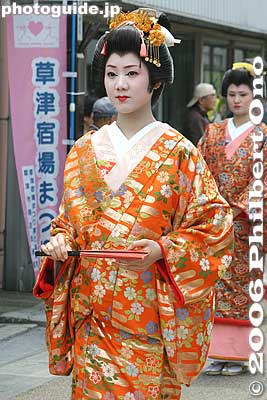
April 29: Kusatsu Shukuba Matsuri celebrates Kusatsu’s history as a stage town on the Nakasendo and Tokaido Roads. Numerous events and activities are held such as flea markets, street & stage performances, and Japanese dances. The main highlight is the Kusatsu Jidai Gyoretsu procession of people dressed in historical costumes from 11:30 am to 2:30 pm. Near JR Kusatsu Station.
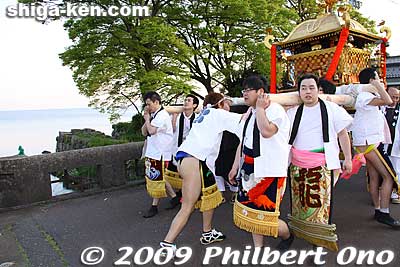
April 29: Kaizu Rikishi Matsuri features men dressed as sumo wrestlers (rikishi) carrying two mikoshi portable shrines around their respective lakeside neighborhoods near JR Makino Station in northern Takashima. They wear kesho mawashi ceremonial aprons. They jostle the mikoshi during the day from 1 pm to 3 pm, and then from 5 pm. At around 8 pm, they proceed to Kaizuten Jinja Shrine for the festival climax with lit torches. Be aware that the festival goes on until after 10 pm which may be past your last train home. Also, if you’re walking back to Makino Station from the shrine, be careful as part of the highway has no sidewalk. Bring a flashlight so the cars (and big trucks) can see you on the road at night. Otherwise, it’s very hazardous. See my video here. Google Map

May 3: Hino Matsuri in Hino is the largest festival in eastern Shiga Prefecture and one of Shiga’s grandest float festivals. Sixteen ornate floats and three portable shrines are paraded through the streets and gather at Umamioka Watamuki Shrine amid festival music of flutes and taiko drums. It’s all day long from morning till late afternoon when the floats leave the shrine. The three portable shrines are taken across town to the Otabisho and back. Buses run from Hino Station to Umamioka Watamuki Shrine. If you have time, I also highly recommend taking the bus from Hino Station to Shakunage Gorge (しゃくなげ渓) for a relaxing nature stroll in a gorge adorned with shakunage (rhododendron), Hino’s official flower. See my video here. Google Map
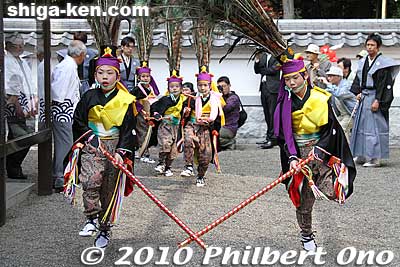
May 3: Kenketo Odori at Takigi Jinja Shrine (龍樹神社) in Tsuchiyama, Koka is a dance performed by eight boys aged 7 to 12. The dance was originally started to ward off calamities. The boys wear tall peacock feathers on their heads. The delightful dance is a National Intangible Folk Cultural Property. From Kibukawa Station (JR Kusatsu Line and Ohmi Railways), catch the Aikuru Bus and get off at Higashi Maeno. The shrine is a short walk toward the river. Also see my video at YouTube. Google Map

May 3: The Kenketo Festival is held at few Shinto shrines in Ryuo and neighboring Higashi-Omi. It is mainly a naginata (pole sword) dance and procession by boys dressed in costume. They travel to these different shrines and perform, but the main venue is Suginoki Shrine in Yamanoue, Ryuo town, Shiga. Also see my YouTube Video here. Google Map
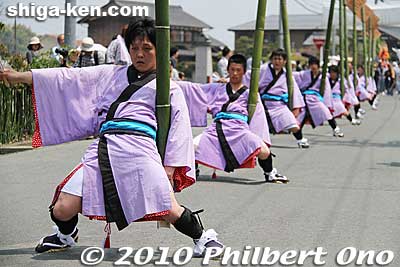
May 4: The Shichikawa Matsuri at Oarahiko Shrine in Takashima features a procession of yakko-furi laborers carrying archery targets (photo), yabusame horse runs, and a portable shrine procession. This is the largest festival in the Kosei area (western Shiga) and the only one featuring horses in Kosei. Attracts a good crowd. The shrine is near Shin-Asahi Station (JR Kosei Line), but renting a bicycle at the station is recommended. See my video here. Google Map
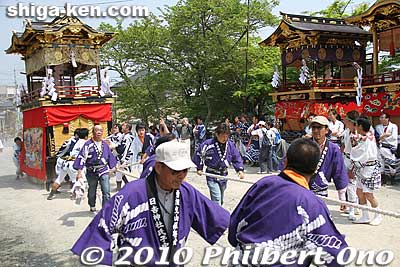
May 4: Omizo Matsuri has five ornate floats pulled around the neighborhood of JR Omi-Takashima Station (JR Kosei Line). The festival eve on May 3 has the floats festooned with paper lanterns as they are pulled around in the evening. On May 4, they pull the floats around during the day and gather at Hiyoshi Jinja Shrine. When entering the shrine, they dramatically run while pulling the float. Also see my video at YouTube. Google Map
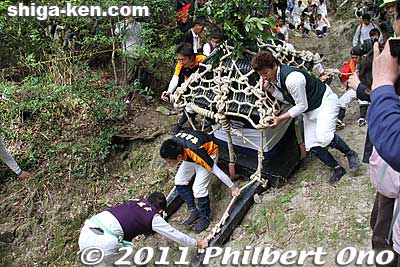
May 4: Iba-no-saka-kudashi Matsuri held by Sanposan Shrine in Higashi-Omi, Shiga Prefecture is an unusual festival with three portable shrines hauled down a steep mountain (Kinugasa-yama) for about 500 meters. It doesn’t sound that far, but it’s all steep, rocky terrain. The mikoshi bearers can easily get injured. This is also one of the hardest festivals to view. You have to climb up this steep, rocky mountain and perch on a ledge. One earthquake and you can fall. The locals have an easy time climbing up the mountain though, even with kids. See my video here. Google Map
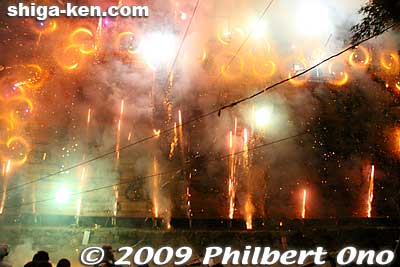
May 4: Shinoda Hanabi is a super spectacular and artistic fireworks display at Shinoda Shrine in Omi-Hachiman. Torch fireworks, Niagara Falls, and panel-type fireworks provide an explosive, close-up experience. For people who cannot wait till summer to see fireworks. Beware of a forest of camera tripods and photographers in front. Get there early if you want to take good shots. Not recommended if you don’t like sudden and loud explosions. Intangible Folk Cultural Property. Walk from Omi-Hachiman Station. Google Map
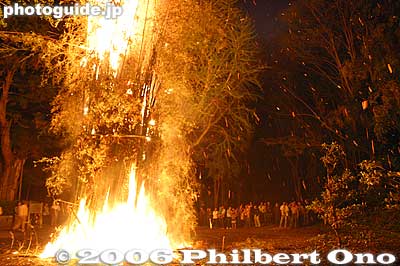
May 4: The Misaki Shrine Fire Festival in Aisho climaxes with a towering clump of bamboo set afire to create a fire column well over 10 meters high. It starts at 7:30 pm when people carry 2-meter long torches from their homes to the shrine. A taiko drum is also carried and beaten. Very dramatic (no marshmallows). The shrine is a 20-min. walk from JR Inae Station. See my video here. Google Map
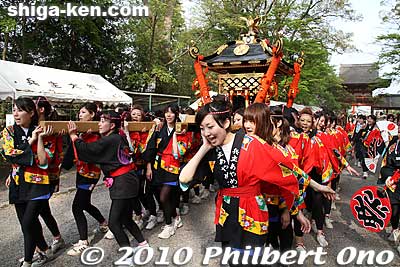
May 5: Hyozu Matsuri is Shiga’s preeminent mikoshi (portable shrine) festival with 35 mikoshi paraded around Hyozu Taisha Shrine in Yasu. Two of them are carried only by spunky young women called “Ayame,” meaning iris flowers. Very colorful and lively festival as they frequently stop, yell, and hold up the mikoshi high in the air. Beware that it can be dusty on the gravel paths. Other mikoshi are carried by children and men. See my video here. Google Map
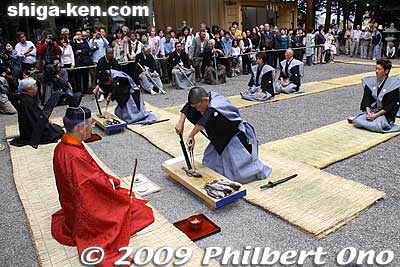
May 5: The Sushi-kiri Matsuri sushi-cutting festival at Shimoniikawa Shrine in Moriyama has two young lads very stylistically and meticulously cutting funa-zushi fermented fish (crucian carp native to Lake Biwa) as an offering. All throughout, they are verbally heckled by some men. Not visually spectacular, but unusual and intriguing. The best part is at the end when they give free morsels of funa-zushi to spectators. Shiga’s best-known delicacy from Lake Biwa. Also see my YouTube video here. Google Map
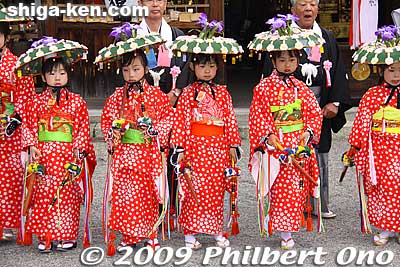
May 5: Naginata Odori Matsuri at Ozu Jinja Shrine in Moriyama consists of colorful dances and music by children, taiko drumming, a naginata dance and acrobatics by boys using a pole sword. They conduct a roundtrip procession from Ozu Shrine to Ozu Wakamiya Shrine. A great variety of eye candy for Children’s Day. Also see my YouTube video here. Google Map
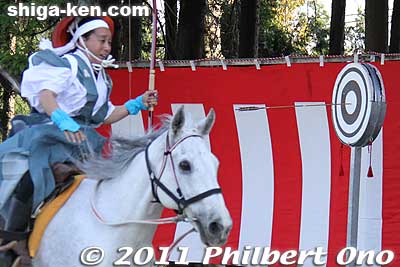
May 5: Sekku Matsuri Festival at Namura Shrine in Ryuo is for horse lovers. After children carry around a portable shrine, yabusame horseback archery is held in front of the shrine gate. Several horses make their runs, but only one of them shoots arrows at the targets. A good excuse to visit this shrine noted for its elegant-looking, thatched-roof main gate and Nishi Honden hall which is a National Treasure. The shrine’s architecture is from the Kamakura Period. See my video here. Google Map



